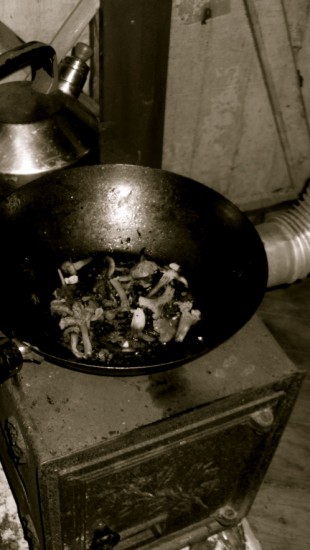By dexter petley
An shorter version of this piece appears in the latest issue of An Antidote To Indifference, edited by Andrews of Arcadia – available in the shop now.
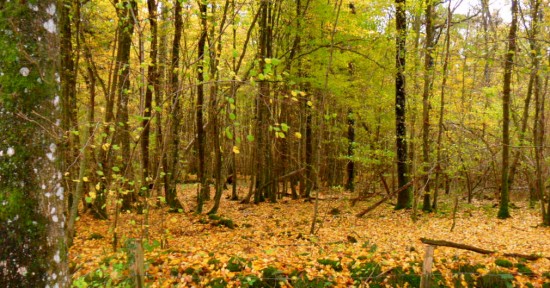
Winter opens with trees dripping in thick mists, thumping on the yurt roof. I listen like a squatter inside a drum. An acorn, a rotton twig, the air too heavy, spilling its wet guts across my canvas dome. Inside, like a bloodhound between cases, I’m waiting for a scent. It’s that time of year, when the clocks go forward like they’ve heard a hunting horn, or a flight of geese passes over their grave. Next day the hunters march down the lane. The forest floor is a yellowneum of leaves like flattened lemons, cast like confetti at the Feast of All Saints. The bracken rots, the bats withdraw, and the moon is a cold slice glinting on the mud. It’s opening day at last. The glorious first of November. Chanterelles, Peter, chanterelles.
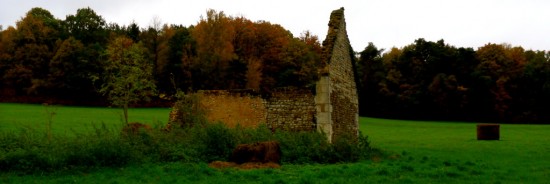
We found the place. Past the ruined stone hut in a woodside field, ungathered haybales sagged and rotting. An old track, mossy banks, the light stifled like a hand over your mouth. It was half a clock off dusk. We saw by the incandescence of glowing leaves. We jumped the moss and waded through bracken the colour of strong tea, snapped into heron leg, till we found the deer tracks, hunters’ brush, the slime, wet braken crushed into food. And they were there, the first chanterelles of winter, the first of Novembers, pushing through sheaves of blackening bracken like crowds lining the streets at liberation. Like carpet nails, Laure said, tacked lightly in the rugs of moss.
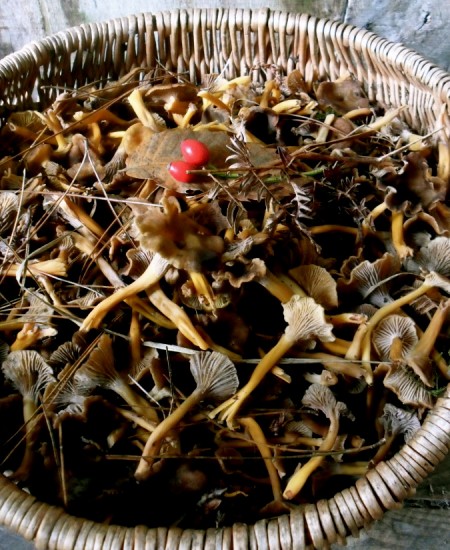
We filled the basket in a parable. Tubular chanterelles you could drink wine from, heap on the beloved’s bed, horde under candle-light or dress the wild hog before battle. We drove home as the verges whitened, the nocturnal birds up late and feasting on spent flies in the headlight beams, thick barrelling mist drifting off the river like a ghost train.
Every November we sound the alert, prick up our ears for the rains, flare nostrils at the decay – the slime on pine, the bracken sludge, the yellowing grass under chestnut trees, the glowing green of mossy ruffs round pine stumps. A nervous fear; supposing they don’t come. What will save us? As if these chanterelles were a rescue party, succour for the stranded, brandy for the parson. It’s a kind of smuggling, yes, because it’s furtive, silent, and a luxury you hide from passing gentlemen on horseback.
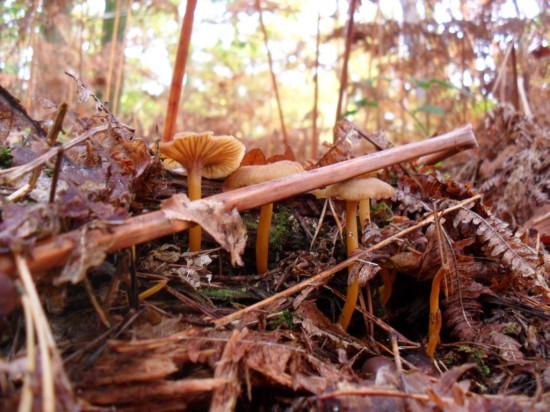
Just their name, chanterelles. The song girls, ballads of the forest floor, acoustic food for an electric omelette? Why not? But, my fancy aside, from Greek to Latin, chanterelle is a drinking vessel, a goblet. Kantharos, cantharellus, only canticles they are, a cup and a song. Minstrels of the fallen, horns for the song of the earth.
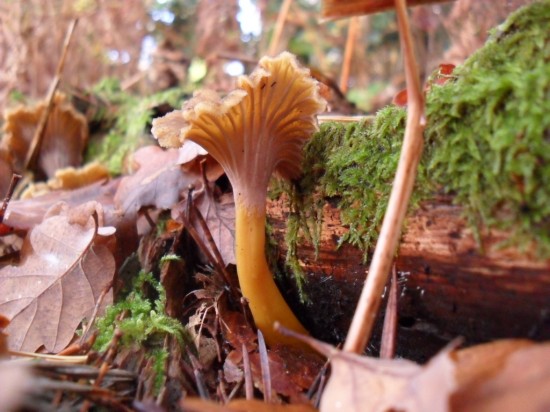
In the sixteenth century they enter historical records as “the fourteenth edible mushroom”. Fourteenth, sporteenth, it’s a fool’s game hit parading mushrooms. Mycologists can be divisive. The mushroom snob walks a narrow path. Within the chanterelloid family there’s even a pecking order which only ever takes account of gastronomics, the culinary celebrity, the price in the market, an obsession which now sediments down to the places where celebrity isn’t welcome. The forest floor.
The chanterelle I exalt is the underdog of them all, the tubular, the lowly fifth in line to its glittering cousin the girolle of the golden glow. Cantharellus tubaeformis, or chanterelle en tube, historically the fodder of the poor, swine mushrooms unfit for emporers. It suffers dismissal, even derision. In current mushroom publications I’ve seen it described as “of no particular culinary interest.” It has only come to notice as edible at all since the second world war, since drastic declines in the number of other species, most notably girolles themselves. Change of land use, excess nitrogeon, acid rain, monoculture, stupidity and greed. As with anything wild or natural, we do not deserve them, and they should never be sold. Mushroom racketeers will get their Eliott Ness.
The tubular chanterelle, faithful to untampered conditions, is a glimpse of perfection when it appears. It is generous, spotless, each one unique as a snowflake, unspoilt by worm or slug, it doesn’t reflect the rot which begets it. Instead, it rejoices as a choir only can. They proliferate in visionary numbers, unlike a long wait in a garden for that bean or leaf, the chanterelle is a night bird, born only at PH critical 5.5, unhurried till the time is right. Then it marches, all hands to the deck, everybody out, harmony before the end of the world. And we should listen to what they say. They don’t have to be there; it’s as moniters of our folly they remain so faithful. Once ectotrophic mycorrhiza is extinguished, the chanterelle will never return. Sulphur dioxide in the air, nitrogeon in the soil, the forest floors become bramble and bilberry where once it was herbs and mushrooms. The herbs are long gone since industrial revolution. Chanterelle, don’t take your love to town.
NOSH NOTES
We must not forget the reason for picking mushrooms; they’re delicious to eat. I may forage from necessity, but I’m also aware that I eat things no billionaire will ever eat; ambrosia itself. When celebrities try and engage with nature on their ten million pound estates, they end up on dialysis. Never try and impress your friends, you’ll end up killing them. Get a bloody mushroom book. I’ve said it before, but mistakes are fatal. I’m always expanding my mushroom larder, but only after cross referencing with four different books, plus internet, plus instinct, which comes with years of dicing with death.
The cooking of a mushroom couldn’t be simpler, but cultural differences confuse the matter. Basically, the British say olive oil or bacon fat, the French say butter. I say all three. The chanterelle is a polyglot, or polyamorous. Olive oil, cold pressed organic rapeseed oil, bacon fat or butter will all suffice, but a mushroom is not a stable rotter. Each month of the year produces mushrooms with different textures and consistencies. Water levels vary, insect behaviour, and actual taste, something the chefs never consider. Wet summers, for instance, can produce tubular chanterelles, but these will be small, yellow and dry. These are best fried in butter on a slow flame or done quickly in oil and garlic. As autumn progresses, mushrooms hold more water. Oil and water don’t mix well, but butter and water produce delicious juices.
The chanterelle en tube is probably the hardiest of mushrooms. It can survive a wet heatwave in July and a freeze up under snow between Christmas and as late as the first week or two of the new year. Unlike most species, whose life span is ephemeral, (ie birth, then attack by maggot, beetle and slug till death as mush), the chanterelle has no predator and is not prone to rot. It can sit there for a month waiting for you to find it. It keeps well once picked, like a winter apple if treated correctly. Frost will blacken them, but they stay upright and edible.
They can be dried, but I prefer to freeze them once cooked. Fully cooked, they turn dark grey to black, whether in butter or oil. For immediate use, fry in a good wok, big knob of salty butter with a dash of olive oil and crushed garlic. Pile the wok high as they’ll reduce to a third. Depending on the time of year or the size or freshness of the mushroom, there may be some water. Don’t drain anything away. Either keep it as sauce or, even better, drain the liquid into a small stone pot and stick it in the fridge. Call it chanterelle butter, or dripping if you substitute with bacon fat. When it’s hard, spread it on toast or oatcakes to eat with farmhouse cheddar or a French salers with pickles, an apple, a glass of dry cider or a good ale, especially while watching cold rain stream down the windows in the shorter dark days of winter.
Chanterelles at christmas are a delight, an original touch if you need one. A layer of black mystery in a home made pork pie. Or served with fried bacon cubes and a dollop of creme fraiche. Look for them under pine trees in December, pushing up under the fallen needles. Take a cutting of fresh green pine needles home with them and fry it in oil, drain the oil off, removing the needles, and cook the chanterelles in this later. The aroma of the pine will please the chanterelles. Likewise, soak the cutting in cold oil till needed.
Once identified, you cannot confuse the tubular chanterelle with any toxic mushroom. If any reader craves the experience, and has a speciman they’d like identified in certitude, do email a photograph, still sitting in its habitat if possible, to Caught By The River for forwarding to me.
